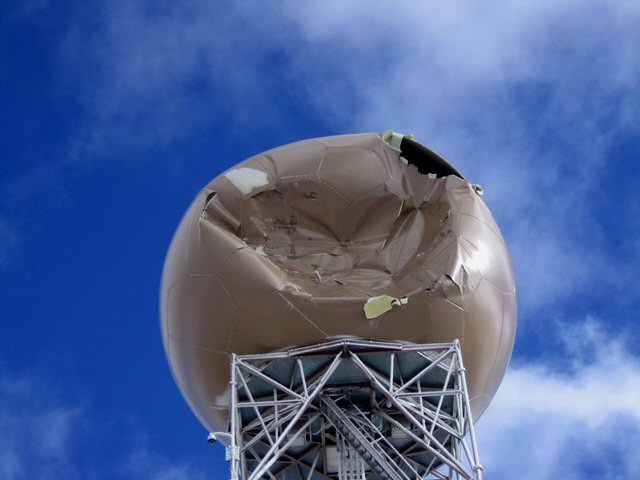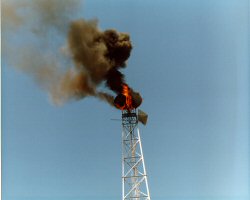
Have you ever thrown a shopping cart out of a convertible at 80 mph to observe the sparks? How about hooking up a power amplifier to 115 volts AC just to see how it craters? Your fellow engineers have done these things and more! If you have a great picture of totally destroyed hardware, or a photo of a blown circuit, send it to us. If it gets on the web site you will receive a free Microwaves101 key chain pocket knife! Impress your friends, if not your boss!
Note to mortuary contributors: please consider that your boss may not find your submission in the best interests of your Big Company. Lately we've been getting a lot of "please remove my submission" emails, try not to send us anything that you might regret.
Note to Big Companies: Don't blame us for posting your spectacular failures, we only post what your employees send us. On the other hand, please don't rip off Microwaves101 pictures for presentations without permission, that's bad manners. Maybe it's time for some training!
Note to mortuary fans: We put new stuff here at the top, but older disasters are still here too--just scroll down.In many cases, if you click on pictures on this page you can see higher resolution images.
Here's a destroyed radome from a National Weather Service radar in Reno Nevada that got caught in 140 mile per hour wind gusts on December 19, 2008. Sent in by Matthew (thanks!) For the full story, visit their web site, there are a lot more images than this one! If you are looking for weather radar images anywhere near Reno Nevada, for now you are out of luck! In the future, the CASA project will populate the US with thousands of low-cost weather radars, and this type of single-point failure will be a thing of the past.

New for December 2008! This burning dish came from Jim.
|
Here's one you might want to include on your site. This picture was taken sometime in the early 80's in Dalton, Georgia. A tech was inside the site doing an inspection when he smelled something burning and the radios started squelching. He just happened to have a 35mm camera with him.
|

Hot path |
These images of a toasted circulator came from Happy_Trails...
This circulator had 2 frequencies running through it —> 10.9925 GHz & 10.9915 GHz with 296W at a 50% duty cycle. The only problem is that nobody put heat sinking
New for October 2008! Here's a pdf document that shows some toasted transformers in Southern Cali, sent in by Bill. We're not sure where the photos originally came from, but we'll leave them in the original document and maybe someone will fill us in on the back story. Thanks, Bill!
New for October 2008! More pictures from Marcelo of Buenos Aires:
And some people worry about asteroids... Apparently, it fell down during a particularly windy day. I´m attaching a couple close-ups of the mounting pole's base, there you can see the tiny fisher anchors that were used to fix the radio. No wonder why it was blown away...
New for September 2008! These pictures came from Laszlo.
We had some technical difficulties and malfunctions, off-line links -- attached pictures show ice problems and one of them shows our hangman just for fun :)
Tower is located at Budapest, Hungary, 350m hilltop. Pictures taken in January, 2004.
By the way, these antennas worked just fine, after they were de-iced...

Also new for September 2008! these pictures came from Marcelo in Buenos Aires.
These are two pictures of an Ericsson Mini-Link E indoor unit that landed in my repair shop. The nasty looking coat you see spread evenly all over the mainboard is the good old mix of dirt and water commonly known as Mud.
Pity I don't have a picture of the repair guy's face when he removed the cover.
He had this "about to puke" look when he came asking "I guess this is beyond repair, right?"
Note from UE - why not send these boards for a ride in the dishwasher before attempting the "repair"...
New for August 2008! This story came from Adam...
I recently had a serious problem with my self-built main CAD machine (Athlon
64 x2 @ 3.02 GHz, 8 GB of DDR-2 800 RAM, 1 TB RAID 10 array... You get the picture). I lost a drive on the RAID array, and the rebuild of the array kept failing... Then lots of bluescreens... Then lockups if I ran more than 3 of the 4 sticks of RAM... Totally bizarre, and I kept replacing things and testing individual parts in other machines trying to find the source of the problem. Weeks later, frustrated and now weeks behind schedule on several custom motorcycle parts projects, I was no closer to a solution. Until I accidentally did something that shouldn't be done, but gave a result far out of proportion with what should have occurred...
Apparently what had happened was that one of the two +12v rails in the power supply had failed --it was now grounded rather than providing +12v, although I never opened the power supply to find out how the problem had come about, exactly. The way I "diagnosed" this was while I was still mucking with the RAID drives, trying to get my precious work out of the remainder of the array (one drive had a dead controller card and was known DOA -- don't know if this was the chicken or the egg in this failure). Well, one of the drives was a "crossover" drive, a SATA 300 drive that had both a SATA and a Molex power connector, with a strict admonition against connecting both at the same time. This shouldn't have caused anything catastrophic... but in my case, I apparently connected the grounded rail to one of the connectors, and the working rail to the other, causing the full rail current to pass through the drive's controller card and out the grounded rail. I caught the burning component smell immediately and yanked the power cable out of the back of the machine, but the deed was done. I gather this was a "sacrificial" power resistor (capacitor? Hard to tell...), but that didn't save the drive coils for the read/write heads... Hoping the drive was still good and only the controller card bad, I tried a known good controller from an identical drive... And ended up with no smoke, but no joy, and two dead controller cards. At least I found the source of my problem (as well as the drain, no gate included!)
Also new for August 2008! These pictures came from "Anonymous in Southern California...
Did some mountain top tower work over the weekend. Saw some stuff (not
ours) that's - umm questionable. . . . Like the Useless Antenna.
Ice damage on an air conditioner housing . . . And, not broken, but have to say, "here is a photo of a big pair of cans."
Click on images for closeups...

Bad VSWR? |

Nice cans |

Ice damage |

Saftey notiss |

Useless antenna |
New for June 2008! This image of the guts of an unscrupulous copy of a circuit breakers comes from
Schneider Electric in the U.K. at the suggestion of Kerry. Let it serve as a warning that counterfeit electronics parts can be deadly!
Kerry also submitted a link to this tower video.. yikes! Caution! Turn down the sound if you don't want to hear the "f-word".
New for June 2008! These photos came from David in Israel.
Here are a few pictures of some unfortunate pieces of hardware. Although, in their life, they were not, strictly speaking, microwave hardware, but they were close support. High voltage power supplies for TWTs, to be exact.
|

This photo shows what happens
to a 10 Amp 115V relay, attempting to
interrupt about 500 Amps of (short
circuit) current.
|

The scarred area in the middle used to be as green as the grass on the other side of the proverbial fence. Look at the far right side for a clue.... The cause – an X7R ceramic capacitor hooked across two prime power phases. X7Rs like to have a DC bias on them; real AC makes them crack and short out.
|
|

A flashover between 115V 3F rectified
bus (makes 270 Vdc and, practically,
as much current as the wiring survives).
Apparently, due to some moisture
condensation upon the (removed)
connector.
|

The mating connector, which was plugged into the one that flashed over (which you can't see 'cause it's been removed…), in the previous picture.
The pins that are missing were not broken off. They literally evaporated into thin air!
(Some of the vapor can be seen to have condensed back onto the PCB in the previous picture.)
|
New for May 2008! This photo came from Dave.
Here's what happens to a static discharging style lightning arrestor when it is in-line with a poorly tuned antenna, Hi-SWR! Burnt enamel wire and toroid core fractured.
I thought I had properly adjusted my vertical antenna for 80M, then hit it with 1 KW from the linear....arc popping and spitting in the amp and no output until I removed this arrestor.
New for May 2008! These came from Nameless Satellite Guy sometimes known as Charlene when he's playing dressup. Click the images to supersize the damage!
Here are photos of what happens when you aren't careful when running a CS01 test, causing two 1-ohm current sense resistors to set fire to their Uralane coating.
New for May 2008 (we've been having a busy month!) This set came from Tim from MN, who simply states:
Apparently ‘school bus’ exceeds the mil spec of this portable radio.
New for April 2008! These two photos came from Zhang in Beijing, illustrating a mechanical interference problem...
Below are two pictures I took when I worked on one SNG truck (SNG means Satellite News Gathering, it is from the Digital Broadcasting Standards of Europe.) It was interesting , it is a dual frequency band system both C and Ku, (See PIC 1), but it seems like they forgot something: when the antenna rotated, the output flange of the C waveguide will be obstructed by the Ku waveguide. (See PIC2).
Finally they made the system work--good job. Well I think it is still a good experience to remember.
New for March 2008! Here's some photos of a board roast from Bob:
I’m submitting pictures of a VME daughter card that failed rather dramatically. The source of the short is unknown, but you can see the extensive fusing and charring on the daughter card plus the proximity burns to the main card. More than a few errant amps went through the wrong path I dare say. In addition to the unmistakable smell of “smoke being let out of chips”, actual smoke was seen coming out of the chassis in question.
We've posted some closeup photos
here,
here, and
here. Someone open a window, that smell is overpowering...
Here's another submission that's new for March 2008! This almost unbelievable example of microwave connector abuse came from Liam:
We found this in our lab a while ago. We never found out who did it but personally I feel that tar and feathering would be too good for them.